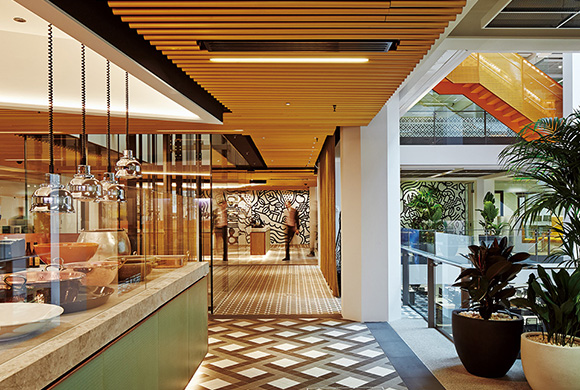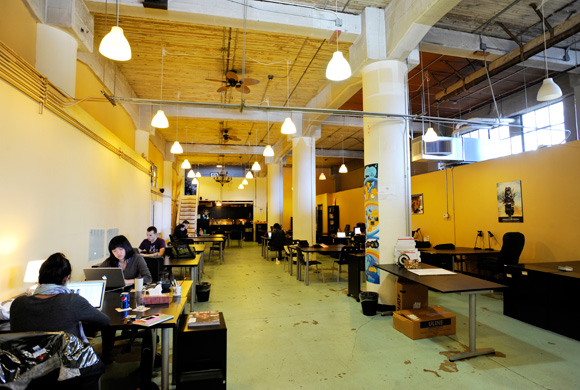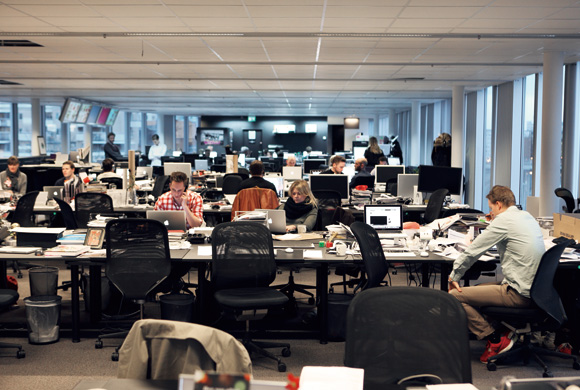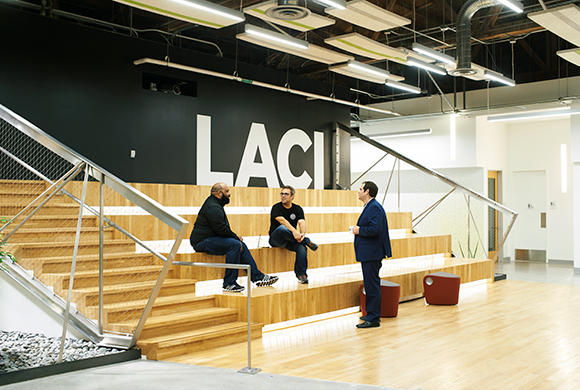Workplace
Nov. 4, 2014
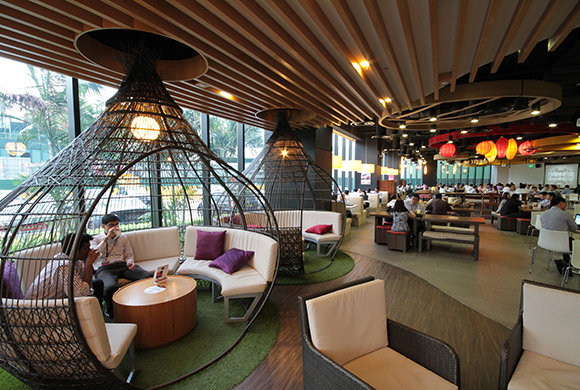
Workplace Transformation
at Singapore’s Largest Bank
Leading Asian bank
[DBS] Singapore
DBS, headquartered in Singapore, was established in 1968 as the Development Bank of Singapore; the name was officially changed in July, 2003. The bank currently has more than 250 branches in 17 countries around the world. Its strategic focus is in the key markets of Southeast Asia, South Asia and Greater China, making it one of the premier financial service companies in Asia. It is rated AA- by Standard & Poor’s, Aa1 by Moody’s (both as of April, 2014), reflecting a very high level of trust in the bank.
DBS’s Asia Hub is one of three major DBS facilities in Singapore. Along with the technology, operations and support departments, branch operation simulation training, leadership training and other educational activities are based here. “This is a nine-storey building with a total area of 340,000 square feet (31,587m2), and is home to approximately 3,000 people, about 40 percent of the total DBS staff headcount in Singapore,” says Erwin Chong, Senior Vice President and Head of Corporate Real Estate Strategy & Administration at DBS Bank.
“The Asian financial market is dynamic and constantly changing,” Mr. Chong says. “For DBS to become the bank providing the best support in Asia in this environment, plans were laid out in 2007 for the front and hub. This was intended to strengthen the relationship among all teams, and to promote increased efficiency and productivity in the company.”
The formerly scattered business locations were brought together in the DBS Asia Hub, while communication among employees was encouraged through enhanced (and quite impressive) open spaces.
“Naturally, the number of meeting spaces were increased,” Mr. Chong says, “We also expanded the spaces with tables and sofas that employees could use without the need for reservations. Of course, employees can communicate by email, but problem-solving is a lot faster when you meet face-to-face.”
It used to be that many employees used outside cafés and other establishments for quick meetings, but it was not an ideal situation. “That is why it was felt that it would be much better to have places within the office where people could very freely discuss matters,” Mr. Chong says. “This is safer, of course, but there is also the possibility of greater collaboration among different teams.”
 DBS Asia Hub is located in Changi Business Park, a center for Singapore’s most advanced businesses.
DBS Asia Hub is located in Changi Business Park, a center for Singapore’s most advanced businesses.
Founded: 1968
Sales: S$5.09 billion (2013)
Employees: Approx. 19,000 (2013)
Web: www.dbs.com.sg/index
 Meeting spaces are located here and there throughout the office, and are used by the employees for quick communications.
Meeting spaces are located here and there throughout the office, and are used by the employees for quick communications.
One unique method for encouraging employee communication is the open space known as Social Hub. “In the past, meeting rooms were located within the office spaces of each floor, so, for example, someone working on the ninth floor would only use the ninth-floor meeting room,” Mr. Chong says. “Because of security, people couldn’t enter floors other than their own.”
So the meeting rooms on each floor were taken out of the interior of the offices space and set “outside” as the Social Hubs. Move to each floor, and there you will find the Social Hub spread out in front of you; behind it is a glass partition setting off the strict security of the office space—this is the image being presented.
“There is a Social Hub on each floor,” Mr. Chong says. “The concept is that these are spaces where anyone can work anywhere within the building, whereas prior to the move, a person could only use their own floor. Now, for example, a person working on the fifth floor can use the Social Hub on the seventh floor. WiFi is available throughout the building, so you’ll see many people working in the Social Hubs on their notebook computers. Employees have meetings, enjoy lunch while relaxing on the sofa—people have more options. There is no distinction between the floors or departments; many employees use the Social Hubs for a range of activities.”
The Melting Pot cafeteria is one more plan for reaching DBS’s goals. The interior gives a feeling of the culture of Singapore. “For example, the chairs are made in the style of Chinese porcelain, while sofas are made of rattan in the style of baskets used in traditional fishing methods of Indonesia and Malaysia,” Mr. Chong says. “The circles on the ceiling are in the shape of the utensils used to steam dim sum.”
It is often said the culture of Singapore is a fusion born of the cultures of China, Malaysia and India—and the cafeteria name reflects this. The Melting Pot has a capacity of 300; the tables can be used to increase the available space so it can also be used as a hall. The room is equipped with a stage, two screens and projectors, so it’s a space that can be used for many purposes.
There is also a 24-hour gym that can be used by all employees. Instructors are also available for yoga, Pilates and other lessons during lunchtime and in the evenings.
Ease of moving things was also naturally part of the goal for the office space. One such feature is the way in which the space near the windows is used. The windows are large, and were designed so that, as much as possible, private rooms were not set close to them, allowing lots of natural light to enter the office. In other words, there was nothing to interrupt the area between the windows and the employee work space, so there is plenty of natural light. In the DBS offices which predated the DBS Asia Hub, too, there were no private office rooms by the windows, so the windows were open to all employees.
So how did employees evaluate these various plans that were incorporated into DBS Asia Hub? “For about six months after the office move, we sent out questionnaires twice asking the same questions,” Mr. Chong says. “There were many people who said they weren’t used to the new offices right after the move, but six months later the responses showed that there was a dramatic increase in the people who felt the new environment was better than the previous one. People said they were collaborating more with other employees.” Thus many employees were expressing what DBS had hoped would occur.
Consultancy for Work Style:in-house
Interior Design:HBO+EMTB
Architect:in-house
 Vending machines are available in the Social Hubs. Drinks and light meals are provided free of charge.
Vending machines are available in the Social Hubs. Drinks and light meals are provided free of charge.

Gym for the use of employees. Many people work out here during lunch and at night.






